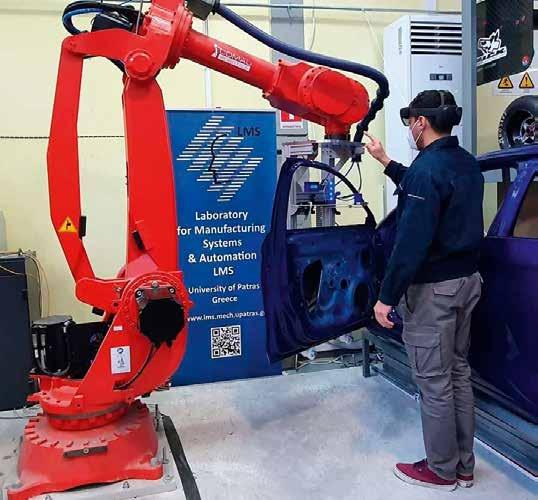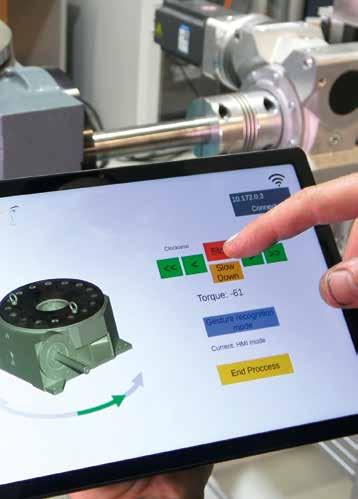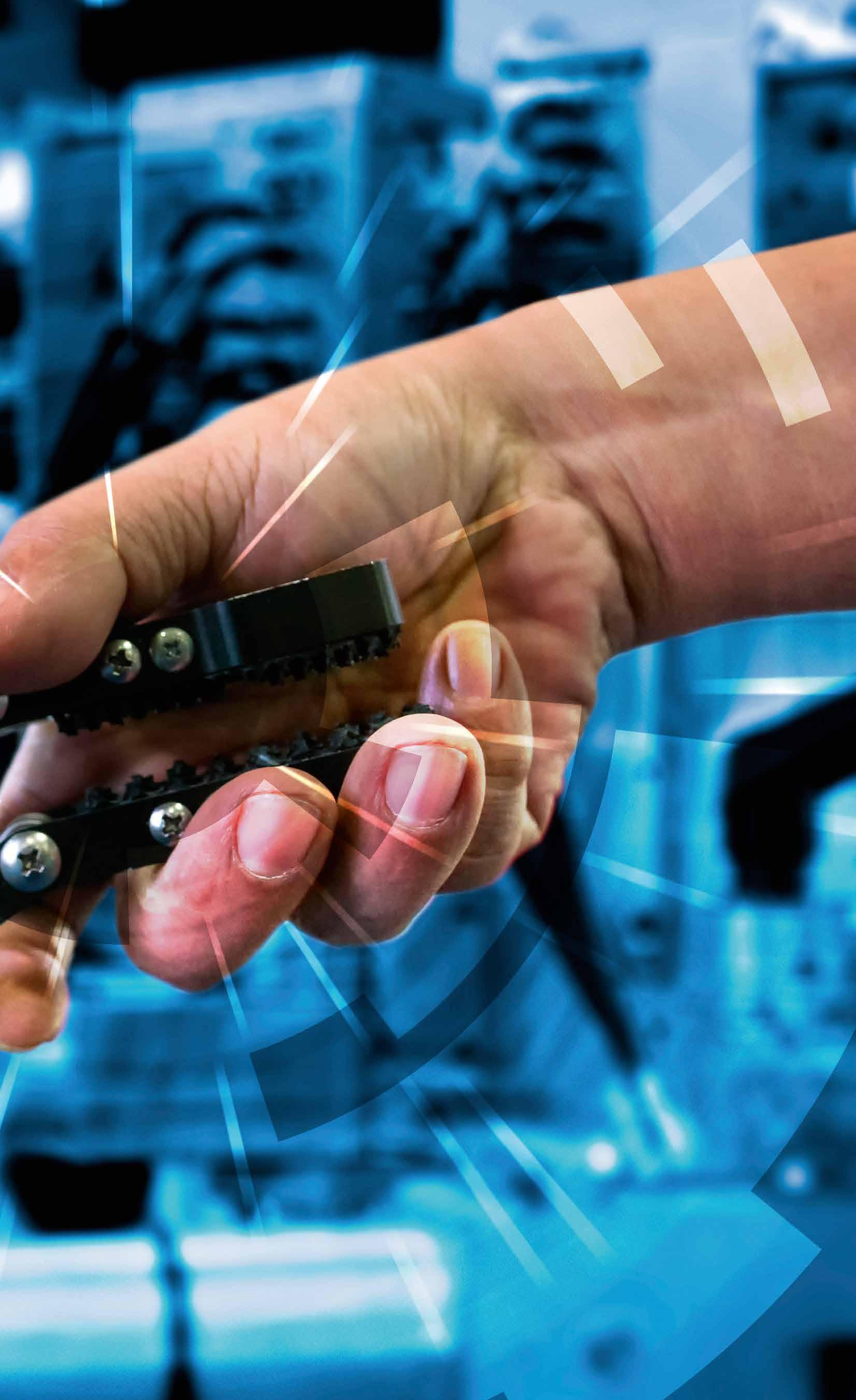
8 minute read
SHAREWORK



Human-Aware robot tasks and motions in CEMBRE use-case. Robot controlled through Augmented Reality in SEAT S.A. use-case. Easy-Programming robot interface in GOIZPER Group use-case.
Share the work, reap the benefits
Effective collaboration between robots and humans can boost productivity in the manufacturing sector and also improve ergonomics for the workforce, bringing wider health benefits. We spoke to Néstor García and Simona Neri about the achievements of the Sharework project in developing a modular collaborative robotics system that allows humans and robots to work together safely and effectively.
An industrial or manufacturing plant can be a physically demanding place to work, with operators often needing to pick up heavy components and move them around. Robots can take on some of these tasks and so reduce the physical burden on human staff, a topic central to the Sharework project, an EU-funded initiative which brings together partners from across Europe. “The idea in the project is to apply robots in a collaborative environment, for example in a manufacturing plant. Introducing robots in these plants will help human operators by improving ergonomics, so reducing injuries and boosting productivity,” says Simona Neri, Programme Manager at Eurecat, coordinator of the Sharework project. There are however some barriers to the introduction of collaborative robots - or cobots - into manufacturing plants, one of which is that human staff are wary of them for fear of losing their jobs, an issue researchers in the project are working to address. “We have gathered feedback from workers. We want to identify the issues they are concerned about when it comes to introducing robots into the workplace,” explains Néstor García, the technical coordinator at Eurecat.
Sharework system
This may vary according to the nature of the workplace, with four separate industrial use cases or demonstrators within the Sharework project in the automotive, railway, metal and capital goods industries. Researchers are using commercially available robots and developing a system of different integrated software modules that will enable humans and robots to work together collaboratively in these different industrial scenarios. “We analysed all the tasks involved in each use case and identified which are the most repetitive and dangerous for operators, then those tasks were placed into the robot’s area of responsibilities,” outlines García. In the automotive use case, the robot is used to pick up heavy objects and components, while it is applied in different ways in other areas of industry. “in the railway use case, an industrial collaborative robot is used for the riveting and the application of silicone during the assembly of train windows and door frames,” he continues. “In the capital collaborative robots and operators, and so helps them work together effectively. “First the environment is analysed – so where are the objects? And where are the human operators? This is so that the robot can understand the trajectory of human workers and adapt its movement accordingly, avoiding any collision,” explains García. Humans may change the order of assembly tasks, so it’s also important that the robot understands what tasks workers are performing, being aware of any obstacles or impediments in the surrounding environment. “With the Sharework system we are able to recognise the objects or tools in a specific scene,” says García.
goods use case, the robot screws bolts, and also helps the worker to perform a quality check, demanding high torque rotations. In the metal use case, the robot is used to help workers in assembly and disassembly tasks involving multiple components.”
The system is designed to work together simultaneously with humans, rather than as a replacement, a prime example of collaborative robotics in industrial scenarios, so an effective and reliable means of communication is essential. An interface developed in the project enables communication between industrial
Research in Sharework has been devoted to developing the software, with the aim of providing a modular solution that can be used in different industries willing to automate their tasks without losing the skills and knowledge of human workers. The end-users of the Sharework system – SEAT S.A., CEMBRE, ALSTOM and GOIZPER Group – provided their requirements and specifications at the beginning of the project, which García says has been invaluable in terms of guiding development. “We have developed some demonstrators and we have been integrating the different


software modules in these four use cases, providing the collaborative robots the necessary knowledge to move throughout the environment safely and without fences limiting the spaces. We have moved these demonstrators to industrial facilities, to be closer to end-users,” he outlines. The idea is to test the solution with workers in manufacturing plants to gather feedback and assess the performance of the system. “We have different performance indicators like the amount of time the cobot is being used, the reduction of the cycle time, or the worker’s ergonomics improvement,” says García. “Specific metrics allow the validation of the Sharework system in each of the four use cases considered in the project.”
Working conditions
The major aim in this research is to improve working conditions in manufacturing plants, in particular helping improve ergonomics, so that employees are more comfortable in their working environment. Removing the need to carry heavy loads would bring wider benefits to both employees and employers, says Neri. “It’s not just about reducing the number of injuries in the workplace, but also improving ergonomics and boosting productivity, as well as fostering gender equality in industrial sectors by reducing the strength capacity needed. This technology can help reduce sick leave and injuries that can result from dealing with heavy components,” she explains. The technology is currently at around TRL 6 (Technology Readiness Level), so there is still some way to go before it reaches practical application, yet Neri believes it holds vast potential. “We see great market opportunities for the system, even just considering the industrial cases that we are working with at the moment,” she continues. “The technology can also be extended to other activities in the same sectors, as well as in other sectors entirely.” There are a wide range of potential applications of this system, such as in the

Safe human-robot collaboration through worker monitoring in ALSTOM use-case.
aviation sector for example, or any other industry which wants to automate certain processes without replacing human staff. A key first step before the technology can be applied more widely is to gain the acceptance of workers, and demonstrate that collaborative robotics technology can help improve their working conditions. “Iterative discussions have been held with the industrial end-users in each of the four use cases, in order to identify the most relevant requirements for their processes and to identify a specific set of metrics that could best represent their needs in terms of productivity, cost, safety and human-related factors,” outlines García. “In parallel with the definition of KPIs targeted to the industrial scenarios, all technological modules of the Sharework have also been investigated. Each module is presented taking into account the situation in the industrial scenario before Sharework implementation, the objectives and targets after Sharework implementation and the methodology to validate the modules’ performance with respect to the state-of-the-art.”
This technology is ultimately designed for practical application, so Neri says researchers have collaborated closely with workers. “We can develop very exciting, interesting systems, but in the end if the workers themselves don’t trust it, if they are afraid of working together with cobots, then our work won’t be applicable to industry,” she acknowledges. The voice of human operators must be represented in the collaborative robotics field and their views taken into account, and the project is now moving into this phase. The technology has been developed and tested in laboratory environments, now Neri says the demonstrators have been moved into the facilities of the end-users, marking another step forward in development. “The operators are testing them, which may tell us whether there are any other factors we need to consider in developing the system. We expect positive results,” she says.
Safe and effective HumAn-Robot coopEration toWards a better cOmpetiveness on cuRrent automation lacK manufacturing processes Project Overview
Sharework project develops a Europe-wide smart modular solution integrated by different software and hardware modules to allow robots to physically interact with humans within a collaborative production environment without the need for physical protection barriers. The project boosts process productivity and improves the ergonomics of those workstations where it is implemented.
Project Partners
Sharework consortium is formed by 15 entities from 6 countries with expertise involving industrial human-robot collaboration technologies, as well as inherent environmental and human factors aspects, innovation and business. https://sharework-project.eu/consortium/
Contact Details
Eurecat Technology Center, Spain E: info@sharework-project.eu W: www.sharework-project.eu
Néstor García Ph.D
Simona Neri Ph.D
Néstor García Ph.D is Sharework technical coordinator and Principal Investigator of the Collaborative Manipulation research group at Eurecat. He holds an B.S. degree in Industrial Engineering and an Ph.D. in Automatic Control, Robotics and Computer Vision from the Polytechnic University of Catalonia (UPC). Simona Neri Ph.D is the Sharework project coordinator and program manager responsible for European funding at Eurecat. With a PhD in supermolecular chemistry and an MBA, she has transitioned to the coordination of projects to bring cutting-edge technologies to industrial environments.


This project has received funding from the European Union’s Horizon 2020 research and innovation programme under grant agreement No 820807.










